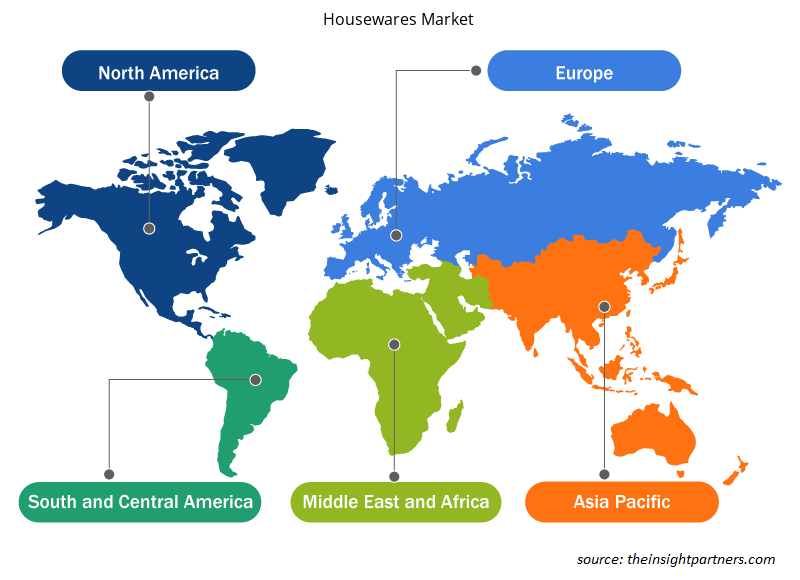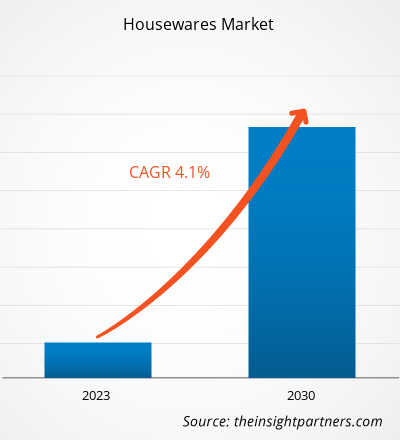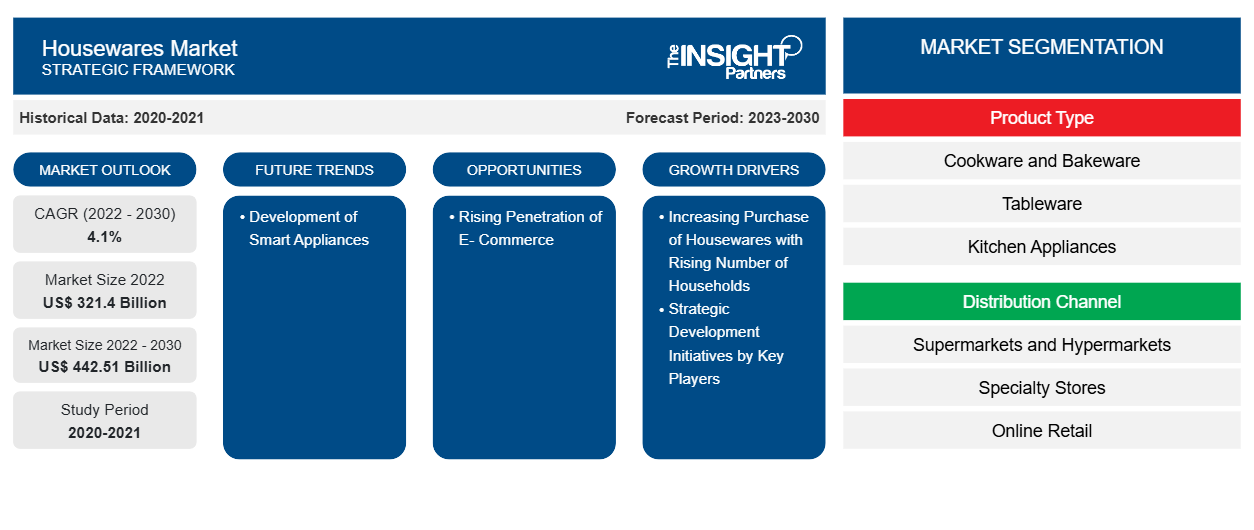[Rapporto di ricerca] Nel 2022 il mercato degli articoli per la casa è stato valutato a 321,40 miliardi di dollari e si prevede che raggiungerà i 442,51 miliardi di dollari entro il 2030; si stima che registrerà un CAGR del 4,1% dal 2022 al 2030.
Approfondimenti di mercato e punto di vista degli analisti:
Gli articoli per la casa sono prodotti e articoli utilizzati in una casa per cucinare, cuocere al forno e organizzare la casa, tra gli altri scopi. Il mercato degli articoli per la casa è cresciuto costantemente a causa di fattori come il cambiamento degli stili di vita e il maggior tempo trascorso a casa, che hanno innescato la domanda di articoli per la casa funzionali ed esteticamente gradevoli. Durante la pandemia di COVID-19, le persone hanno trascorso più tempo a casa e hanno investito nel migliorare i propri spazi abitativi. Inoltre, l'aumento delle piattaforme di e-commerce e di shopping online ha reso più facile per i consumatori accedere e acquistare un'ampia gamma di prodotti per la casa dalle loro case. Questi fattori, uniti a design innovativi e opzioni sostenibili messe a disposizione dalle aziende di articoli per la casa, favoriscono l'espansione del mercato degli articoli per la casa.
Fattori di crescita e sfide:
I cambiamenti dinamici nello stile di vita e l'aumento delle famiglie con doppio reddito hanno portato a un aumento dei redditi disponibili e a un miglioramento degli standard di vita delle famiglie. Con l'aumento dei redditi disponibili, i consumatori spendono cifre significative in articoli per la casa e altri elettrodomestici che supportano una vita comoda. Spesso sono disposti ad acquistare nuovi prodotti grazie ai loro stili unici, che fanno appello alla loro individualità, con conseguente maggiore frequenza di acquisto. Inoltre, un numero crescente di famiglie mononucleari innesca la necessità di modifiche alla casa, stimolando così la domanda di articoli per la casa come elettrodomestici da cucina, pentole, teglie, stoviglie e articoli essenziali per il bagno.
Inoltre, un aumento dell'urbanizzazione ha rafforzato la domanda di unità residenziali e, in ultima analisi, di prodotti per la casa. Secondo l'US Census Bureau e l'US Department of Housing and Urban Development, gli Stati Uniti hanno completato la costruzione di circa 1,3 milioni di unità abitative nel 2021, mentre erano in corso la costruzione di circa 1,7 milioni di unità abitative. Allo stesso modo, la crescente urbanizzazione nei paesi europei ha creato un'enorme domanda di alloggi residenziali. Secondo la Commissione europea, i permessi di costruzione residenziale sono aumentati del 42,3% dal 2015 al 2021 nell'Unione europea. Nel 2021, Francia, Germania e Polonia hanno rappresentato il maggior numero di inizi di costruzione residenziale in Europa. Pertanto, la crescente costruzione di unità abitative in vari paesi aumenta ulteriormente la domanda di articoli per la casa. Pertanto, l'aumento degli acquisti di articoli per la casa insieme al crescente numero di famiglie spinge la crescita del mercato degli articoli per la casa.
Tuttavia, il mercato degli articoli per la casa è altamente frammentato e disorganizzato a causa di molte piccole imprese private e venditori ambulanti non sfruttati che operano nei paesi in via di sviluppo. Secondo un articolo pubblicato su Business Standards, nel 2020, l'80% del mercato degli articoli per la cucina era disorganizzato in India. Le piccole imprese locali utilizzano materie prime di bassa qualità per produrre articoli per la casa come pentole, teglie, accessori per il bagno e stoviglie. L'utilizzo di materie prime di bassa qualità si traduce in prodotti finali di scarsa qualità che sono inclini a danneggiarsi. Inoltre, i produttori offrono questi prodotti a costi bassi; pertanto, la maggior parte dei consumatori acquista questi prodotti per la convenienza e la facile reperibilità. Questo fattore si traduce nella contrazione della base di clienti dei principali produttori di articoli per la casa.
Inoltre, più spesso, i produttori locali nel mercato non organizzato degli articoli per la casa non rispettano gli standard normativi, il che può sollevare problemi di qualità e ostacolare la percezione dei consumatori verso i prodotti per la casa. Inoltre, la disponibilità di prodotti contraffatti può ostacolare l'immagine del marchio dei principali attori. Pertanto, la mancanza di uniformità nelle operazioni e nelle normative ostacola la crescita del mercato degli articoli per la casa.
Personalizza questo report in base alle tue esigenze
Riceverai la personalizzazione gratuita di qualsiasi report, comprese parti di questo report, o analisi a livello nazionale, pacchetto dati Excel, oltre a usufruire di grandi offerte e sconti per start-up e università
-
Scopri le principali tendenze di mercato in questo rapporto.Questo campione GRATUITO includerà analisi di dati che spaziano dalle tendenze di mercato alle stime e alle previsioni.
Segmentazione e ambito del report:
Il mercato globale degli articoli per la casa è segmentato in base al tipo di prodotto, al canale di distribuzione e alla geografia. In base al tipo di prodotto, il mercato è categorizzato in pentole e teglie, stoviglie, elettrodomestici da cucina, articoli essenziali per il bagno e altri. In base al canale di distribuzione, il mercato è categorizzato in supermercati e ipermercati, negozi specializzati, vendita al dettaglio online e altri. In base alla geografia, il mercato globale degli articoli per la casa è ampiamente segmentato in Nord America, Europa, Asia Pacifico, Medio Oriente e Africa e Sud e Centro America.
Analisi segmentale:
In base al tipo di prodotto, il mercato degli articoli per la casa è suddiviso in pentole e teglie, stoviglie, elettrodomestici da cucina, articoli essenziali per il bagno e altri. Si prevede che il segmento delle stoviglie registrerà il CAGR più elevato nel periodo 2022-2030. Il segmento delle stoviglie include prodotti come stoviglie, posate, bicchieri e stoviglie da portata. Un aumento della domanda di stoviglie nel mercato degli articoli per la casa può essere attribuito alle trasformate abitudini alimentari durante la pandemia di COVID-19. Con più persone che cenano a casa, le persone hanno iniziato a concentrarsi su stoviglie estetiche e funzionali, poiché migliorano l'esperienza culinaria domestica. Dai pasti quotidiani alle riunioni speciali, i consumatori sono alla ricerca di set di stoviglie che esaltino la loro esperienza culinaria. Inoltre, il crescente apprezzamento per i design unici e artigianali svolge un ruolo significativo nel guidare la domanda di stoviglie. I consumatori sono sempre più attratti da pezzi di stoviglie artigianali e di ispirazione artistica che conferiscono un tocco di individualità e personalità ai loro ambienti da pranzo. Pertanto, uno spostamento verso scelte di stoviglie più personalizzate e visivamente sorprendenti ha contribuito al progresso del mercato degli articoli per la casa per il segmento delle stoviglie. Vivo - Villeroy & Boch Group, Corelle, Pyrex, Luminarc e Schott Zwiesel sono alcuni dei principali attori operanti nel mercato delle stoviglie.
Analisi regionale:
Il mercato degli articoli per la casa è suddiviso in cinque regioni chiave: Nord America, Europa, Asia Pacifico, Sud e Centro America e Medio Oriente e Africa. L'Asia Pacifico ha dominato il mercato globale degli articoli per la casa nel 2022, poiché il mercato in questa regione è stato valutato a 120,63 miliardi di dollari USA in quell'anno. L'Europa è un secondo importante contributore, detenendo una quota di mercato globale superiore al 23%. Si prevede che l'Asia Pacifico registrerà un CAGR considerevole di oltre il 5% nel periodo 2022-2030. La crescente urbanizzazione e il reddito disponibile della popolazione della classe media sono un fattore primario che spinge la domanda di articoli per la casa moderni e convenienti, tra cui elettrodomestici da cucina avanzati ed eleganti stoviglie.
Approfondimenti regionali sul mercato degli articoli per la casa
Le tendenze regionali e i fattori che influenzano il mercato degli articoli per la casa durante il periodo di previsione sono stati ampiamente spiegati dagli analisti di Insight Partners. Questa sezione discute anche i segmenti e la geografia del mercato degli articoli per la casa in Nord America, Europa, Asia Pacifico, Medio Oriente e Africa e Sud e Centro America.

- Ottieni i dati specifici regionali per il mercato degli articoli per la casa
Ambito del rapporto sul mercato degli articoli per la casa
| Attributo del report | Dettagli |
|---|---|
| Dimensioni del mercato nel 2022 | 321,4 miliardi di dollari USA |
| Dimensioni del mercato entro il 2030 | 442,51 miliardi di dollari USA |
| CAGR globale (2022-2030) | 4,1% |
| Dati storici | 2020-2021 |
| Periodo di previsione | 2023-2030 |
| Segmenti coperti |
Per tipo di prodotto
|
| Regioni e Paesi coperti |
America del Nord
|
| Leader di mercato e profili aziendali chiave |
|
Densità degli attori del mercato: comprendere il suo impatto sulle dinamiche aziendali
Il mercato degli articoli per la casa sta crescendo rapidamente, spinto dalla crescente domanda degli utenti finali dovuta a fattori quali l'evoluzione delle preferenze dei consumatori, i progressi tecnologici e una maggiore consapevolezza dei vantaggi del prodotto. Con l'aumento della domanda, le aziende stanno ampliando le loro offerte, innovando per soddisfare le esigenze dei consumatori e capitalizzando sulle tendenze emergenti, il che alimenta ulteriormente la crescita del mercato.
La densità degli operatori di mercato si riferisce alla distribuzione di aziende o società che operano in un particolare mercato o settore. Indica quanti concorrenti (operatori di mercato) sono presenti in un dato spazio di mercato in relazione alle sue dimensioni o al valore di mercato totale.
Le principali aziende che operano nel mercato degli articoli per la casa sono:
- Casa Bradshaw Inc.
- La Denby Pottery Co Ltd
- Società HF Coors Co Inc.
- Inter Ikea Holding Bv
- Società di produzione Hutzler Inc.
Disclaimer : le aziende elencate sopra non sono classificate secondo un ordine particolare.

- Ottieni una panoramica dei principali attori del mercato degli articoli per la casa
Impatto della pandemia di COVID-19:
La pandemia di COVID-19 ha inizialmente ostacolato il mercato globale degli articoli per la casa a causa della chiusura delle unità produttive, della carenza di manodopera, dell'interruzione delle catene di fornitura e dell'instabilità finanziaria. L'interruzione delle operazioni in vari settori a causa del rallentamento economico causato dall'epidemia di COVID-19 ha frenato la fornitura di articoli per la casa. Inoltre, vari negozi sono stati chiusi, il che ha limitato le vendite di articoli per la casa. Tuttavia, le aziende hanno iniziato a guadagnare terreno poiché le limitazioni precedentemente imposte sono state revocate in vari paesi nel 2021. Inoltre, l'implementazione di campagne di vaccinazione COVID-19 da parte dei governi di diversi paesi ha alleviato la situazione, portando a un aumento delle attività commerciali in tutto il mondo. Diversi mercati, incluso il mercato degli articoli per la casa, hanno registrato una crescita dopo l'allentamento dei lockdown e delle restrizioni alla circolazione.
Scenario competitivo e aziende chiave:
Bradshaw Home Inc, Denby Pottery, HF Coors Co Inc, Inter Ikea Holding Bv, Hutzler Manufacturing Co Inc, TTK Prestige Ltd, Newell Brands Inc, BSH Hausgerate GmbH, Kohler Co e Haier US Appliance Solutions Inc sono tra i principali attori che operano nel mercato globale degli articoli per la casa.
- Analisi storica (2 anni), anno base, previsione (7 anni) con CAGR
- Analisi PEST e SWOT
- Valore/volume delle dimensioni del mercato - Globale, Regionale, Nazionale
- Industria e panorama competitivo
- Set di dati Excel
Report recenti
Testimonianze
Motivo dell'acquisto
- Processo decisionale informato
- Comprensione delle dinamiche di mercato
- Analisi competitiva
- Analisi dei clienti
- Previsioni di mercato
- Mitigazione del rischio
- Pianificazione strategica
- Giustificazione degli investimenti
- Identificazione dei mercati emergenti
- Miglioramento delle strategie di marketing
- Aumento dell'efficienza operativa
- Allineamento alle tendenze normative























 Ottieni un campione gratuito per - Mercato degli articoli per la casa
Ottieni un campione gratuito per - Mercato degli articoli per la casa